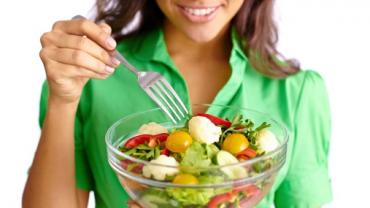
Salad: it’s a prized staple of some people’s diets and the bane of others’ existences. For those who grew up knowing “salad” as nothing more than a bowl of ho-hum iceberg lettuce with some shredded carrots and sliced cucumbers thrown in for excitement it’s no wonder salad isn’t a welcome sight at the table. But there’s a whole world beyond flavorless light-green leaves. A world that not only makes a large salad a substantial meal but a delicious and nutritious one at that.
Romaine lettuce can jazz things up a bit by adding a slightly darker color and more nutrition than iceberg lettuce but why stop there? Thanks to the staggering variety of produce available in most grocery stores now we need not be limited to only the greens that are most familiar. Some of the other greens and small cabbages available year round can add crunch color and a hefty dose of nutrients to salads whether they serve as an appetizer or are the main dish.
Here’s a look at how three lettuces and cabbages stack up in terms of the percent daily value (DV) per 100-gram serving:
|
|
Vitamin A |
Vitamin K |
Vitamin C |
Folate |
Manganese |
Potassium |
|
43% |
289% |
11% |
35% |
21% |
9% |
|
|
1% |
319% |
13% |
15% |
7% |
9% |
|
|
47% |
136% |
25% |
24% |
16% |
11% |
Radicchio is a rock star! Not only does this small reddish-purple colored cabbage add great color to a dish but it’s a vitamin K powerhouse too. Endive and arugula also deliver high amounts of vitamin K along with substantial amounts of folate and vitamin C. Vitamin C is not heat-stable so it’s helpful to get some from foods typically consumed raw. (Other than citrus fruits good sources of vitamin C that are often consumed raw include tomatoes onions and bell peppers.) On the other hand grilling is a popular way to prepare radicchio particularly in Italian cooking. This brings out the vegetable’s natural sweetness. (Even better when combined with balsamic vinegar and romano cheese!) Radicchio is slightly bitter but this may be welcome in a salad that’s presented as a starter since bitter flavors may help to stimulate digestive secretions.
Arugula is a tender green with a distinctive peppery bite. It can be consumed on its own but when added to a salad of mixed greens it helps add a sophisticated depth of flavor. Because of its bitterness it pairs well with sweet foods. Arugula is often combined with juicy watermelon and salty firm feta cheese in a refreshing summer salad. In cooler autumn weather arugula is dynamite with pears and goat cheese. A salad of arugula with pumpkin seeds and shaved parmesan in a red wine vinaigrette is an easy way to impress dinner guests.
As for endive like radicchio it lends itself to hot and cold preparations. It can be braised or served in a gratin with ham and cheese. Eaten raw in a salad classic pairings for endive are blue cheese pears and walnuts or pecans. (Also great with dried cranberries for a little sweetness to blend with the tangy pungent blue cheese.) Individual leaves of raw endive can be used as “boats” or holding vessels for chicken tuna or egg salad as simple but eye-catching hors d’oeuvres. (Also a fun way for kids to eat with their hands! May be especially helpful for kids who are gluten or grain-free – no bread needed.)
These vegetables are equal-opportunity ingredients – suitable for just about every dietary approach there is: Paleo vegan vegetarian low-carb ketogenic and more. They’re extremely low in calories carbohydrates and fat. People can consume a large quantity of them without racking up energy density or spiking blood glucose and insulin. They’re high in fiber and by weight their largest component is water! Per 100-gram serving of endive radicchio or arugula between 91 and 94 grams are water. Instead of seeing this as a waste of money think how amazing it is that so many nutrients are crammed into foods that are mostly water. Plus a large crisp salad is a good way for people who tend to skimp on their water intake to get some water without forcing themselves to gulp down more than they’re inclined to. Add some vinegar maybe some olives and it’s a wonderful way to take salads from boring to beautiful.